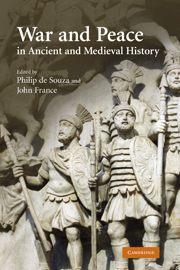Book contents
- Frontmatter
- Contents
- List of contributors
- Acknowledgements
- Note on abbreviations
- 1 Introduction
- 2 Making and breaking treaties in the Greek world
- 3 War, peace and diplomacy in Graeco-Persian relations from the sixth to the fourth century bc
- 4 Treaties, allies and the Roman conquest of Italy
- 5 Parta victoriis pax: Roman emperors as peacemakers
- 6 Treaty-making in Late Antiquity
- 7 Byzantine diplomacy: good faith, trust and co-operation in international relations in Late Antiquity
- 8 Treaties between Byzantium and the Islamic world
- 9 Siege conventions in Western Europe and the Latin East
- 10 Paying the Danegeld: Anglo-Saxon peacemaking with vikings
- 11 Peace among equals: war and treaties in twelfth-century Europe
- Bibliography
- Index
1 - Introduction
Published online by Cambridge University Press: 09 August 2009
- Frontmatter
- Contents
- List of contributors
- Acknowledgements
- Note on abbreviations
- 1 Introduction
- 2 Making and breaking treaties in the Greek world
- 3 War, peace and diplomacy in Graeco-Persian relations from the sixth to the fourth century bc
- 4 Treaties, allies and the Roman conquest of Italy
- 5 Parta victoriis pax: Roman emperors as peacemakers
- 6 Treaty-making in Late Antiquity
- 7 Byzantine diplomacy: good faith, trust and co-operation in international relations in Late Antiquity
- 8 Treaties between Byzantium and the Islamic world
- 9 Siege conventions in Western Europe and the Latin East
- 10 Paying the Danegeld: Anglo-Saxon peacemaking with vikings
- 11 Peace among equals: war and treaties in twelfth-century Europe
- Bibliography
- Index
Summary
War and peace are familiar terms to historians, yet in Antiquity and the High Middle Ages they conveyed a variety of meanings. The ten new essays in this book examine the processes of the making and breaking of peace treaties and truces, challenging many traditional assumptions. They discuss how far political conventions and legalities mattered in agreements that were based not so much on trust as on recognition of the practical limits of military and political power, and they show how conventions and solemn agreements were frequently reinterpreted and manipulated for political ends. We begin with four chapters that span a period of a thousand years from Classical Greece to Imperial Rome.
In the first of these chapters, P. J. Rhodes analyses a series of important peace treaties from the Greek world of the fifth and fourth centuries bc, examining how far the specific terms of an agreement really mattered to the different parties, and what it took to break a treaty. He does not feel that the Classical Greek states were consciously deceitful in their dealings with each other, but argues that during the fourth century bc they tended to insert ambiguous clauses into their treaties, which they would be able to interpret to their own advantage.
Eduard Rung's chapter considers how international relations were conducted between the Greek states and their powerful eastern neighbour, the Achaemenid Persian Empire.
- Type
- Chapter
- Information
- War and Peace in Ancient and Medieval History , pp. 1 - 5Publisher: Cambridge University PressPrint publication year: 2008



